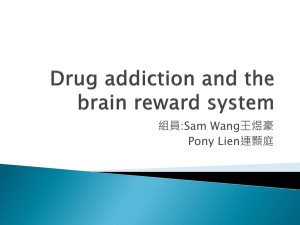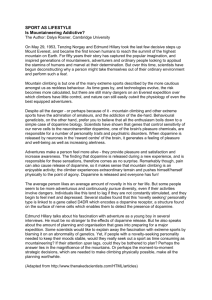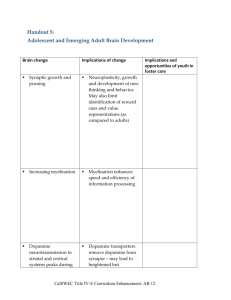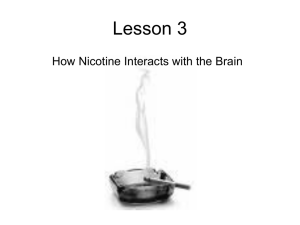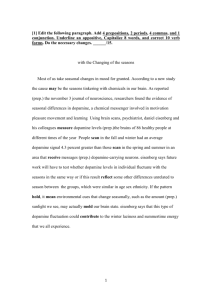Alcohol and Dopamine
advertisement
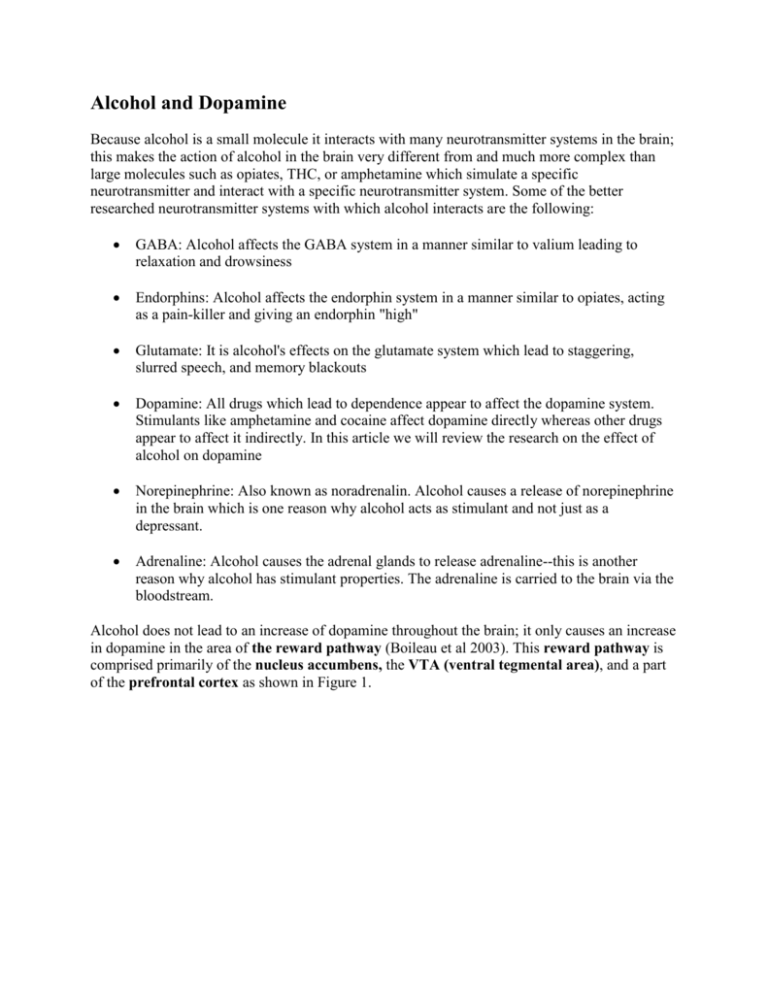
Alcohol and Dopamine Because alcohol is a small molecule it interacts with many neurotransmitter systems in the brain; this makes the action of alcohol in the brain very different from and much more complex than large molecules such as opiates, THC, or amphetamine which simulate a specific neurotransmitter and interact with a specific neurotransmitter system. Some of the better researched neurotransmitter systems with which alcohol interacts are the following: GABA: Alcohol affects the GABA system in a manner similar to valium leading to relaxation and drowsiness Endorphins: Alcohol affects the endorphin system in a manner similar to opiates, acting as a pain-killer and giving an endorphin "high" Glutamate: It is alcohol's effects on the glutamate system which lead to staggering, slurred speech, and memory blackouts Dopamine: All drugs which lead to dependence appear to affect the dopamine system. Stimulants like amphetamine and cocaine affect dopamine directly whereas other drugs appear to affect it indirectly. In this article we will review the research on the effect of alcohol on dopamine Norepinephrine: Also known as noradrenalin. Alcohol causes a release of norepinephrine in the brain which is one reason why alcohol acts as stimulant and not just as a depressant. Adrenaline: Alcohol causes the adrenal glands to release adrenaline--this is another reason why alcohol has stimulant properties. The adrenaline is carried to the brain via the bloodstream. Alcohol does not lead to an increase of dopamine throughout the brain; it only causes an increase in dopamine in the area of the reward pathway (Boileau et al 2003). This reward pathway is comprised primarily of the nucleus accumbens, the VTA (ventral tegmental area), and a part of the prefrontal cortex as shown in Figure 1. Moreover, the experimental evidence suggests that alcohol does not cause the increase in dopamine directly. Rather, it appears that alcohol directly affects the GABA system and the endorphin system. Neurons from the GABA system extend into the reward pathway and when alcohol affects the GABA system these neurons release dopamine into the reward pathway. Likewise, neurons extend from the endorphin system into the reward pathway and these also release dopamine into the reward pathway when alcohol directly stimulates the endorphin system (Boileau et al, 2003). All things which give us pleasure, from a symphony to food to sex to drugs and alcohol, cause a release of dopamine in the reward pathway as well as triggering a number of other events in the brain including endorphin release and activation of the orbitofrontal region of the prefrontal cortex. Researchers from the 1950s who implanted electrodes into the reward pathway thought that they had discovered the pleasure center of the brain (Olds, 1956). However, research since then has demonstrated that pleasure is a far more complex phenomenon which involves many parts of the brain. Contemporary researchers believe that pleasure has several components such as "liking," "wanting," "learning (pavlovian conditioning)," "reward," and "valuation" (Berridge and Kringelbach, 2008). Many researchers currently believe that dopamine in the reward pathway is involved in the phenomena of "wanting," "learning," and "reward," but that it is not involved "liking" or "valuation." In other words, the dopamine in the reward pathway may make you crave drugs or alcohol or sex or a symphony, and it may also reinforce habitual drug use, sex, or symphony listening, but it is not responsible for the pleasure you get from these activities. The pleasure which we get from these things seems to involve neurotransmitters called endorphins and to involve hedonic hot spots. Researchers identify the hedonic hot spots as existing in the Nucleus Accumbens, Ventral Pallidum, and Parabrachial Nucleus as illustrated in Figure 2 (Berridge and Kringelbach, 2008). You may recall that the Nucleus Accumbens is also a part of the reward pathway; this tells us that part of the Nucleus Accumbens is involved in "liking" and part of it is involved in "wanting." The orbitofrontal area of the prefrontal cortex is largely involved in the "valuation" of pleasurable stimuli. The reward pathway is an important survival mechanism for the individual and the species--it fosters learning by rewarding us for actions which result in the acquisition of food or sex. This leads us to learn these behaviors as conditioned responses. There is also nothing inherently wrong in using alcohol or other drugs to chemically stimulate the hedonic hot spots and the reward pathway; the vast majority of people who engage in recreational alcohol intoxication or recreational drug use do not become dependent. We should, however, use caution and try to avoid daily use if we wish to avoid alcohol or drug dependence. It is well known that alcohol has the properties of both a stimulant and a depressant; this is due to the fact that alcohol affects many different neurotransmitter systems. However, it is unlikely that the increase in dopamine is responsible for the stimulant properties of alcohol. Although the stimulant properties of cocaine and amphetamine are due to their effect on the dopamine system, these drugs differ from alcohol in that they affect dopamine receptors directly and hence have an impact on dopamine receptors throughout the entire brain, whereas alcohol affects dopamine receptors indirectly and only in one small part of the brain, namely the reward pathway. It is most likely that the stimulating effects of alcohol are due to its effects on adrenaline, norepinephrine, and the prefrontal cortex. Alcohol causes the release of norepinephrine in the brain (McDougle et al 1995). It also causes the pituitary to release hormones which signal the adrenal glands to release adrenaline (NIAAA 1996). Finally, alcohol represses the functioning of the prefrontal cortex (Volkow et al 1990) which is responsible for decision making. This is why alcohol can cause people to lose their inhibitions and make some really bad ideas, like calling up the boss and chewing him out in the middle of the night, sound perfectly reasonable. We should also note that the action of alcohol is biphasic: when BAC (blood alcohol concentration) levels are rising, the stimulant properties of alcohol are more pronounced; when BAC levels are falling, the depressant effects of alcohol are more pronounced (Giancola and Zeichner 1997). It is alcohol's effect on the GABA system which is responsible for its depressant effects. It is also important to note that the term "depressant" refers to drugs which slow down the central nervous system; it does not refer to drugs which induce depression. These are properly referred to as "depressogenic" drugs. The relationship of alcohol to depression is fairly complex; although alcohol can induce depression in some long term heavy drinkers, Denning and Little (2011) note that alcohol can also function as an antidepressant in some drinkers, particularly women. Moreover, some people with depression use alcohol to escape from it. Agonists are drugs which mimic a neurotransmitter, antagonists are drugs which block a neurotransmitter, and partial agonists are drugs which have some of the properties of both agonists and antagonists. Some dopamine agonists have been shown to increase impulsive and addictive behaviors (Kolla et al 2010); however, dopamine partial agonists may aid in reducing addictive behaviors (Diana 2011). REFERENCES: Acquas E, Meloni M, Di Chiara G. 1993. Blockade of delta-opioid receptors in the nucleus accumbens prevents ethanol-induced stimulation of dopamine release. Eur J Pharmacol 230:239– 241. http://www.ncbi.nlm.nih.gov/pubmed/8380771 Berridge KC, Kringelbach ML. (2008). Affective neuroscience of pleasure: reward in humans and animals. Psychopharmacology (Berl). 199(3):457-80.. http://www.ncbi.nlm.nih.gov/pubmed/18311558 http://www.ncbi.nlm.nih.gov/pmc/articles/PMC3004012/pdf/nihms257672.pdf Boileau I, Assaad JM, Pihl RO, Benkelfat C, Leyton M, Diksic M, Tremblay RE, Dagher A. (2003). Alcohol promotes dopamine release in the human nucleus accumbens. Synapse. 49(4):226-31. http://www.ncbi.nlm.nih.gov/pubmed/12827641 Denning P, Little J. (2011). Practicing Harm Reduction Psychotherapy, Second Edition: An Alternative Approach to Addictions. The Guilford Press. Diana M. (2011). The dopamine hypothesis of drug addiction and its potential therapeutic value. Front Psychiatry. 2:64. http://www.ncbi.nlm.nih.gov/pubmed/22144966 http://www.ncbi.nlm.nih.gov/pmc/articles/PMC3225760/pdf/fpsyt-02-00064.pdf Giancola PR, Zeichner A. (1997). The biphasic effects of alcohol on human physical aggression. J Abnorm Psychol. 106(4):598-607. http://www.ncbi.nlm.nih.gov/pubmed/9358690 Kolla BP, Mansukhani MP, Barraza R, Bostwick JM. (2010). Impact of dopamine agonists on compulsive behaviors: a case series of pramipexole-induced pathological gambling. Psychosomatics. 51(3):271-3. http://www.ncbi.nlm.nih.gov/pubmed/20484726 McDougle CJ, Krystal JH, Price LH, Heninger GR, Charney DS. (1995). Noradrenergic response to acute ethanol administration in healthy subjects: comparison with intravenous yohimbine. Psychopharmacology (Berl). 118(2):127-35. http://www.ncbi.nlm.nih.gov/pubmed/7617798 NIAAA (1996) Alcohol Alert No. 32: Alcohol and Stress. http://pubs.niaaa.nih.gov/publications/aa32.htm Olds J. (1956). Pleasure centers in the brain. Sci Am 195:105–116. Olsen RW, Hanchar HJ, Meera P, Wallner M. (2007). GABAA receptor subtypes: the "one glass of wine" receptors. Alcohol. 41(3):201-9. http://www.ncbi.nlm.nih.gov/pubmed/17591543 http://www.ncbi.nlm.nih.gov/pmc/articles/PMC2852584/pdf/nihms27065.pdf Volkow ND, Hitzemann R, Wolf AP, Logan J, Fowler JS, Christman D, Dewey SL, Schlyer D, Burr G, Vitkun S, et al. (1990). Acute effects of ethanol on regional brain glucose metabolism and transport. Psychiatry Res. 35(1):39-48. http://www.ncbi.nlm.nih.gov/pubmed/2164230 http://dionysus.psych.wisc.edu/lit/articles/VolkowN1990a.pdf Copyright © 2012, The HAMS Harm Reduction Network
